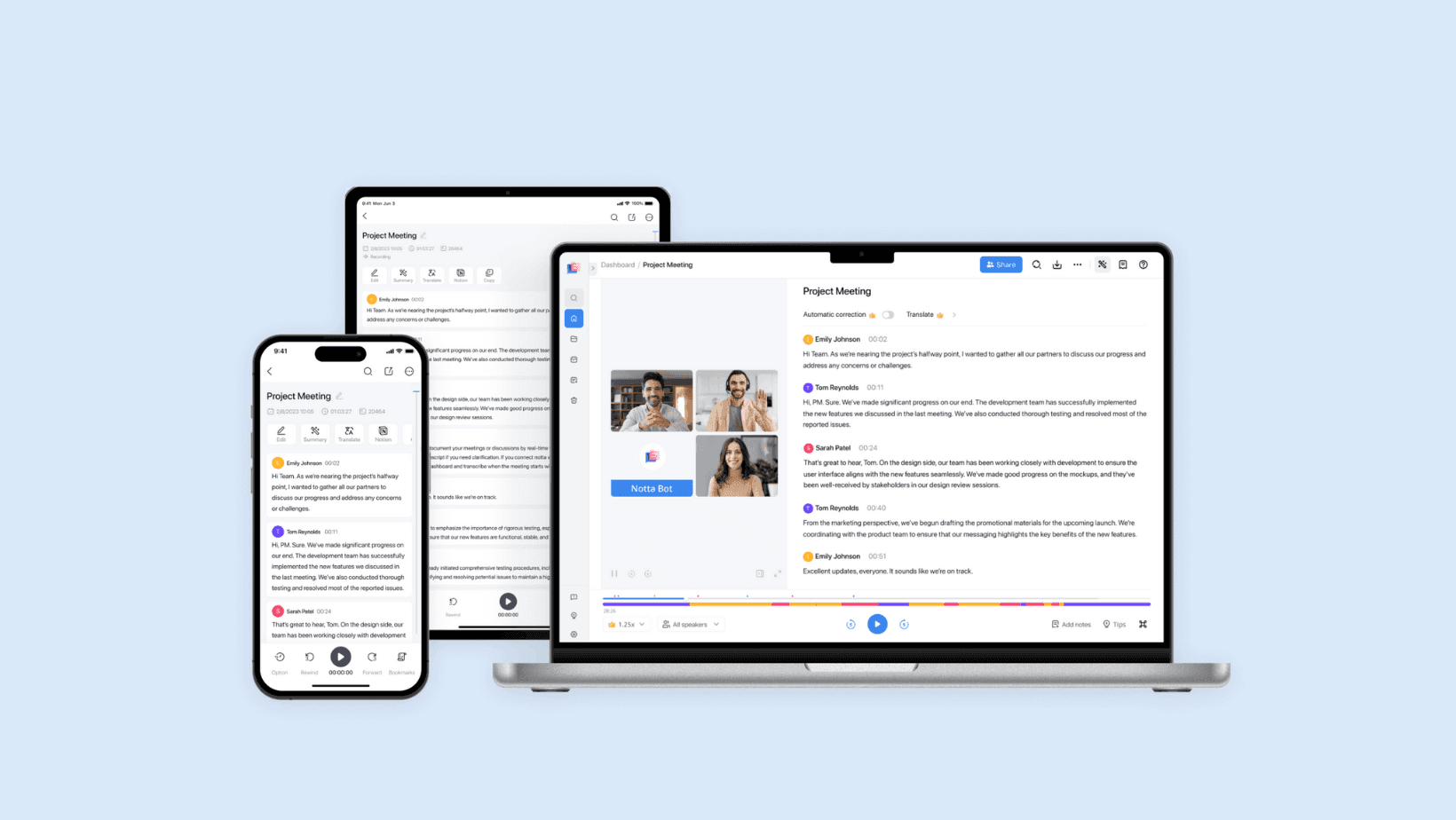Research And Design
8 Types of Qualitative Research Design
Discover 8 types of qualitative research design with clear examples and methods to choose the right approach for your study.
Sep 28, 2025
Qualitative research is a powerful tool that allows you to understand human behavior, thoughts, and experiences. When it comes to conducting qualitative research, having a solid Research and design is crucial. This is where types of qualitative research design come into play. Understanding the various types of qualitative research designs can help you select the most suitable approach for your study, ensuring that you collect meaningful and accurate data.
In this guide, we will examine the various types of qualitative research designs, their key characteristics, and the circumstances under which they are most suitable for application. This knowledge will enable you to design adequate qualitative research studies that produce valuable insights.
Furthermore, we will introduce you to Otio's AI research and writing partner, a tool that can help you research fast and write accurately with AI. This tool will help you quickly understand the types of qualitative research designs and how to apply them to your own research.
Table Of Contents
Importance of Qualitative Research

The Significance of Qualitative Research in Market Analysis
In the diverse field of market research, over 90% of professionals incorporate qualitative data in their studies, with a third engaging in these methodologies monthly. This prevalence is attributed to the unique advantages qualitative research offers, which are often absent in other analytical approaches.
Open-Ended Data Collection
Qualitative research stands out as the most open-ended form of data collection. The data, expressed in words, provides insights that extend beyond the reach of numerical data. Its flexibility allows for a richer understanding of the subject matter.
Targeted Responses
This research approach delivers more targeted or direct answers to specific questions. It avoids the pitfalls of concluding based solely on statistical significance, which can sometimes be misleading.
Sensitivity to Change
Qualitative methods are adept at detecting changes over time within sample populations. This is particularly useful for monitoring shifts in opinions related to products or social issues.
Speed and Efficiency
One of the most practical benefits of qualitative research is the ability to collect data rapidly. Information is gathered almost instantly through verbal communication or observation, significantly reducing both time and cost compared to other research methods.
8 Types Of Qualitative Research Design

1. Ethnography: Observing Natural Behaviors
Ethnography is a qualitative research method focused on studying people and their behaviors within their natural environments. The researcher immerses themselves into the daily lives of their subjects, becoming a participant or observer to experience and understand the culture, customs, and traditions firsthand. This method yields detailed, descriptive accounts, enabling readers to grasp the essence of the studied culture. It is an in-depth approach that, while time-consuming, provides valuable insights into human behavior.
2. Historical Study: Learning from the Past
Historical studies examine past events, people, and documents to conclude relevant to the present and future. This research method relies heavily on the accuracy and validity of primary sources and historical data. It can result in biographical studies, aiming to provide context and understanding by analyzing past occurrences. For example, studying previous advertising campaigns can help inform strategies for future marketing efforts.
3. Grounded Theory Method: Developing New Theories
The grounded theory method begins with data collection or a research question, aiming to develop a theory through the analysis of interviews and documents. It is commonly used in corporate settings to understand customer satisfaction and loyalty. By identifying patterns and themes in the data, researchers can uncover the reasons behind consumer behaviors and propose improvements. This method involves larger sample sizes and utilizes coding techniques to analyze complex processes and generate new theoretical insights.
4. Phenomenology: Exploring Individual Experiences
Phenomenology seeks to understand how people experience and interpret specific phenomena. It acknowledges the subjective nature of reality and aims to describe the diverse perspectives of participants. The findings reveal common themes, providing a deeper understanding of the phenomenon under study. This method is valuable for exploring emotional, psychological, and social dimensions of human experience.
5. Narrative Method: Telling Stories
The narrative method involves collecting and presenting data in the form of a story. Researchers gather information through interviews, observations, and document analysis, then organize the events chronologically. This approach highlights conflicts, themes, and challenges, making it helpful in understanding customer experiences and informing product development. For example, studying the personal stories of individuals affected by COVID-19 can provide insights into their coping mechanisms and ongoing needs.
6. Case Study Method: In-Depth Analysis of a Specific Case
Case studies focus on a single individual, group, organization, event, or phenomenon, examining it within its real-life context. This qualitative research approach aims to provide a comprehensive understanding of the subject, often highlighting unique or significant aspects. Case studies can be either exploratory or explanatory, and they are helpful for theory building. For example, analyzing the life of a person who suffered a traumatic brain injury can reveal the impact on their behavior and inform rehabilitation strategies.
7. Action Research: Collaborative and Empowering
Action research emphasizes collaboration, empowerment, and flexibility. It is particularly suited for working with marginalized groups, allowing participants to have a say in the research process. This method aims to address social issues and improve conditions through collective inquiry and action. For example, researchers might work with young people experiencing housing instability to identify solutions and create a more stable living environment.
8. Focus Groups: Uncovering Attitudes and Perceptions
Focus groups are a valuable tool for exploring people's attitudes, perceptions, and beliefs. A moderator leads a group of participants through discussions, often over multiple sessions, to gather insights on a particular topic. This method is frequently used in product testing, where participants provide feedback on their experiences with the product. For instance, a beverage company might conduct focus groups to evaluate a new energy drink and gain a deeper understanding of consumer preferences.
Related Reading
• What Is Secondary Market Research
• What Are The Limitations Of Market Research
• What Is A Qualitative Research Question
• What Is The Purpose Of Market Research
• Qualitative Research Design
• What Is Quantitative Market Research
• Correlational Research Design
• Computer Science Research Topics
• Types Of Research Methods In Psychology
6 Types of Qualitative Research Questions

1. Descriptive Qualitative Research Questions
Descriptive questions aim to capture the characteristics or features of a product or service. These questions help us understand how users perceive and interpret various aspects of the product. For example, how users describe their initial impressions when they first interact with a new software interface. Alternatively, we could inquire about the specific colors and design elements that users notice when they first see a new smartphone model. These questions offer valuable insights into the visual and sensory qualities of the product, informing design decisions.
2. Exploratory Qualitative Research Questions
Exploratory questions investigate how things work or how users interact with a product. These questions help us uncover the strategies, behaviors, and patterns that emerge when users engage with our product. For instance, what strategies do users employ to navigate through the features of a newly launched app? Alternatively, we could investigate how users attempt to resolve problems when they encounter errors using our digital service platform. These questions shed light on the user journey and reveal opportunities for improving the overall experience.
3. Experiential Qualitative Research Questions
Experiential questions focus on the user's experiences and emotions related to the product. These questions help us understand the feelings, attitudes, and perceptions that users have while interacting with our product. For example, we might ask users to describe a memorable experience they had while using our product. Or, we could inquire about the emotions they feel when using our product under stressful conditions. These questions offer valuable insights into the human side of product usage, helping us design for empathy and emotional connection.
4. Comparative Qualitative Research Questions
Comparative questions examine differences between products, user groups, or other variables. These questions help us identify strengths, weaknesses, and areas for improvement by comparing our product to others or by looking at different segments of our user base. For instance, how do the experiences of new users with our product compare to those of long-term users? Alternatively, we could examine how our product performs in comparison to a competitor's product under similar conditions. These questions provide context and perspective that can guide strategic decision-making.
5. Process-oriented Qualitative Research Questions
Process-oriented questions investigate the sequences of actions or steps that users take when interacting with a product or service. These questions help us understand workflows, routines, and habits that shape the user experience. For example, we might ask users to walk us through the process they typically follow when setting up our product for the first time. Or, we could inquire about the steps they take when troubleshooting an issue with our product. These questions reveal the operational aspects of product usage and highlight opportunities for streamlining and optimization.
6. Theoretical Qualitative Research Questions
Theoretical questions seek to uncover the underlying principles or theories that explain user behavior or product dynamics. These questions help us connect the dots between observed phenomena and abstract concepts, enabling us to make informed predictions and decisions. For instance, what theories can explain why users prefer our product's design over traditional design? Alternatively, we could investigate the psychological principles that influence how users adapt to our product's innovative features. These questions provide a foundation for evidence-based design and innovation.
Related Reading
• Research Design Examples
• What Is Syndicated Market Research
• What Is The Difference Between Basic And Applied Research
• Different Types Of Research Methods
• Types Of Qualitative Research Methods
• Market Research Vs Marketing Research
• Review Paper Vs Research Paper
• Research Process In Business Research Methodology
• Political Science Research Topics
• Non Experimental Research Design
How to Develop a Qualitative Research Design in 12 Steps

1. Use Otio
Content overload is the reality for knowledge workers, students, and researchers today. The problem is compounded by the fact that we have to deal with it using fragmented, complex, and manual tools. Most people end up stitching together a bunch of complicated bookmarking, read-it-later, and note-taking apps just to get through their workflows. This is not sustainable.
Otio is an AI-native workspace explicitly designed for researchers. It allows you to collect data from a wide range of sources, extract key takeaways with detailed AI-generated notes, and create drafts using the sources you’ve collected. This can help you go from a reading list to a first draft much faster and can also assist with writing research papers or essays.
2. Formulate the Research Questions
The first step in developing a qualitative research design is to identify what you want to explore. Good qualitative research questions are open-ended, exploratory, and focused on understanding meanings, experiences, or processes rather than producing simple yes/no answers. Your questions guide all subsequent decisions, and you should verify whether they truly necessitate qualitative exploration.
3. Reflect on Your Theoretical Stance
Every qualitative design rests on assumptions about knowledge. Whether you align more closely with interpretivism, constructivism, critical theory, or post-positivism, your epistemological foundation determines how you perceive your role as a researcher, how you interact with participants, and what constitutes valid knowledge. Including a reflexivity or positionality statement makes your assumptions transparent.
4. Review the Literature
A design needs to be situated in existing research. Reviewing what is already known will help you refine your questions, identify gaps, and justify why your study matters. Consider whether secondary data sources, such as archival materials, documents, or social media, could complement your primary research.
5. Plan Sampling and Recruitment
Next, decide who will provide the data. Ask yourself who is best placed to answer your research questions. Will you use purposive sampling, theoretical sampling, or snowball sampling? Estimate the number of participants you need, and consider access and gatekeepers. Recruitment almost always takes longer than expected, so plan extra time.
6. Choose Data Collection Methods
Once you know who you need to talk to, decide how you will collect data. Options include interviews, focus groups, participant observations, diaries, or creative methods. You also need to decide whether this will be face-to-face, online, or another format. The process should be chosen to suit both your questions and your participants. Piloting an interview guide or procedure can help identify problems early.
7. Decide on Your Analytic Approach
Qualitative analysis is not one-size-fits-all. Use thematic analysis, grounded theory, narrative analysis, discourse analysis, or IPA, depending on your question. Some methods require iterative cycles of collecting and analyzing data, while others allow you to gather all the data before coding. Your choice of analysis should be clear from the beginning, because it influences how you frame your questions and collect your data.
8. Work Out the Logistics
A research design also needs a practical plan. Create a realistic timeline for recruitment, data collection, transcription, analysis, and writing. Identify the resources you need, such as funding, travel, transcription services, or software. Always build in extra time, as qualitative work is often more time-consuming than expected.
9. Address Ethical Considerations
Ethics is central to qualitative research. You need to plan for informed consent, confidentiality, and anonymity. Consider risks to participants and how to minimize them. Pay attention to power dynamics and how your own role may affect participants’ responses. If you need IRB or ethics board approval, you’ll need detailed consent forms, recruitment scripts, and data protection plans.
10. Pilot the Study
Before fully launching, it’s wise to test your instruments and procedures. A pilot with one or two participants can help you refine your questions, check that your methods work in practice, and anticipate logistical problems.
11. Manage Data and Software
Think about how you will handle the large amounts of qualitative data you will produce. Will you transcribe interviews yourself or outsource them? Which software will you use to code and organize the data — Quirkos, NVivo, or ATLAS.ti? Plan a secure system for backing up and storing data in line with ethical standards.
12. Write the Research Plan
Finally, bring everything together into a written plan or protocol. This should include your epistemology and reflexivity, literature review, sampling and recruitment strategy, data collection methods, analytic approach, timeline, resources, and ethical considerations. This plan is both a guide for yourself and a document that can be submitted for approval or funding.
Supercharge Your Research Ability With Otio — Try Otio for Free Today
Otio is an AI-native workspace designed to help researchers deal with content overload. It allows you to collect, extract key takeaways, and create draft outputs from a wide range of data sources. Using Otio, you can go from reading list to first draft faster, and even write research papers/essays with ease. Here are some of the top features of Otio that will help you in your research: AI-generated notes on all bookmarks (YouTube videos, PDFs, articles, etc.) Chat with individual links or entire knowledge bases, just like you chat with ChatGPT AI-assisted writing.
Otio has web scraping capabilities that allow you to access a wide range of data sources beyond traditional academic papers and search engines. This feature enables researchers to collect diverse information from sources like bookmarks, tweets, books, and YouTube videos, streamlining the process of curating and analyzing data for research purposes. Let Otio be your AI research and writing partner — try Otio for free today!
Related Reading
• Causal Comparative Research Design
• Importance Of Research Design
• Best AI for Market Research
• How To Conduct Market Research For A Startup
• How To Start A Research Paper
• Components Of Research Design
• How To Use Google Trends For Market Research
• Ai Market Research Tools




